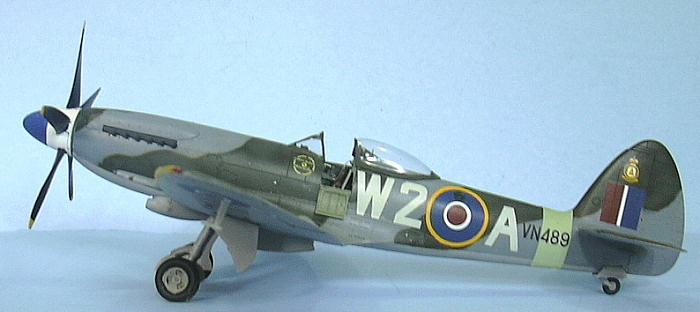
Eduard 1/48 Spitfire 24
| KIT #: | 1121 |
| PRICE: | $54.95 MSRP |
| DECALS: | Four options |
| REVIEWER: | Tom Cleaver |
| NOTES: | Airfix rebox that includes resin and photo etched parts |

| HISTORY |
The Spitfire 21/22/24 were to the
Griffon-engined Spitfire series what the Mk.VIII had been to the Merlin-60
powered Spitfires, i.e., the airframe designed from the outset to make the
maximum use of the most powerful version of the Griffon engine.
These final Spitfires featured a modified wing with a
blunt tip and larger ailerons, as well as a four-cannon armament. The Spitfire
21, which featured the original Spitfire fuselage, entered production at the
very end of 1944, and equipped 41 Squadron in late February 1945.
The unit was able to fly only a few operational coastal
patrol missions off the low countries at the end of April, 1945, claiming their
only victory on April 21, 1945.
The Spitfire 22, which first appeared in the spring of
1945, featured the cut-down fuselage with bubble canopy utilized by the
late-production Spitfire IX, Spitfire XVI and Spitfire XIV and Spitfire XVIII.
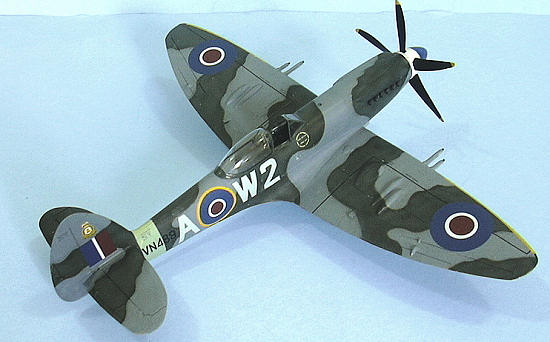 Following the end of the war, the
decision to continue production of the Spitfire had more to do with the
political need to prevent a complete rundown of the aviation industry, than
anything to do with an operational need for the aircraft.
The result was that the manufacture of the Spitfire
21/22/24 continued, although in far fewer quantities than originally ordered,
despite the aircraft’s manifest obsolescence at the dawn of the jet age.
Following the end of the war, the
decision to continue production of the Spitfire had more to do with the
political need to prevent a complete rundown of the aviation industry, than
anything to do with an operational need for the aircraft.
The result was that the manufacture of the Spitfire
21/22/24 continued, although in far fewer quantities than originally ordered,
despite the aircraft’s manifest obsolescence at the dawn of the jet age.
The Spitfire 24 was the last
Spitfire, and differed from the Spitfire 22 primarily in having increased fuel
tankage behind the cockpit, and hard points in the wings for the carriage of
rockets, since it was a dedicated ground-attack aircraft.
Many Spitfire “purists” say it isn’t really a Spitfire;
compared to the Mk.I that had appeared only ten years earlier, it looked very
much like a Spitfire on steroids, having a top speed that was 130 percent of the
original, while having nearly double the empty weight and possessed of twice the
rate of climb, with a weight of fire from its 4 20mm cannon being four times
heavier than that of the eight rifle-caliber weapons carried by a Mk. I.
The Spitfire 21 and 22 had
encountered directional stability problems with their larger propellers and more
powerful engines, even though they used the large vertical fin and rudder
introduced on the Mk. XIV.
The solution to this was to re-fit the Spitfire 22s with
the larger tail designed for the Supermarine Spiteful, with an even-larger
vertical fin and rudder, and horizontal stabilizer and elevators of increased
span.
Only 81 Spitfire 24s were produced, 27 of which were late-production Mk.
22 aircraft modified with the increased tankage.
The 54 new-build Spitfire 24s had the Spiteful tail as
standard on the production line and were equipped with the short barreled
Hispano Mk 5 20mm cannon.
The first Spitfire 24 was delivered at South Marston on
April 13, 1946.
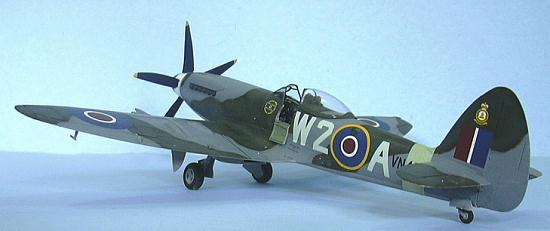 By the end of 1946, the only
front-line home squadrons still operating Spitfires were 41, equipped with
F.21s, and No 63 flying the LF Mk XVIe. The Auxiliary Air Force was reformed
that June and 13 of its squadrons were equipped with Spitfires, being a mixture
of Spitfire 21s and 22s, or LF XVIe.
In January 1948, 80 Squadron, which was attached to 2nd
Tactical Air Force in Germany and still operating the Tempest V, became the only
squadron equipped with the Spitfire 24.
The last Spitfire 24 came off the production line in
October 1947 and was delivered in February 1948 direct to 80 Squadron.
By the end of 1946, the only
front-line home squadrons still operating Spitfires were 41, equipped with
F.21s, and No 63 flying the LF Mk XVIe. The Auxiliary Air Force was reformed
that June and 13 of its squadrons were equipped with Spitfires, being a mixture
of Spitfire 21s and 22s, or LF XVIe.
In January 1948, 80 Squadron, which was attached to 2nd
Tactical Air Force in Germany and still operating the Tempest V, became the only
squadron equipped with the Spitfire 24.
The last Spitfire 24 came off the production line in
October 1947 and was delivered in February 1948 direct to 80 Squadron.
As the Chinese Civil War came to a climax in the summer of 1949, it was decided that the Crown Colony of Hong Kong needed an air defense unit to keep mainland Chinese forces at bat. That September, 80 Squadron with their Spitfire 24s were transferred to Hong Kong, arriving in late October after the victory of the Communist forces on the mainland. When the Korean War began in June 1950, thought was given to sending the squadron into that conflict since they were trained in ground attack. Instead, the squadron remained in Hong Kong, flying patrols until they were re-equipped with deHavilland Hornets in January 1952. The remaining F.24s continued in service with the Hong Kong Auxiliary Air Force until April 1955. The last Spitfire 24 to take to the air was VN485, which took its final flight on April 21, 1955, a bit more than 9 years since the type had first taken flight. All but three of the remaining Spitfires were bulldozed into the harbor and utilized as landfill when the runway for Kai Tak Airport was extended. Two of these last three were returned to the U.K. where they are now found in museums, with the third on display in Hong Kong.
| THE KIT |
Airfix released the Spitfire 22/24
and the Seafire 46/47 in 1995.
This marked the first completely new kit from Airfix in
over 15 years, and it was considered fully “state of the art” with engraved
detail and sharp trailing edges.
The one thing anyone could really complain abo ut
was the incorrect shape of the bubble canopy, which resulted in it riding high
on the fuselage if posed in the open position.
The cockpit was sparse, but Aires came to the rescue
with an excellent resin cockpit, while Falcon/Squadron released a correct canopy
for both Spitfires and Seafires (the Seafire 47 having a different windscreen).
The poor decal sheet (which could be used with effort)
could also be supplanted with a decal sheet from Aeromaster.
For the really serious purist, Cooper Details released a
correction set for the radiators, rudder and propellers, which also included a
very detailed resin cockpit.
ut
was the incorrect shape of the bubble canopy, which resulted in it riding high
on the fuselage if posed in the open position.
The cockpit was sparse, but Aires came to the rescue
with an excellent resin cockpit, while Falcon/Squadron released a correct canopy
for both Spitfires and Seafires (the Seafire 47 having a different windscreen).
The poor decal sheet (which could be used with effort)
could also be supplanted with a decal sheet from Aeromaster.
For the really serious purist, Cooper Details released a
correction set for the radiators, rudder and propellers, which also included a
very detailed resin cockpit.
The kit went out of production at the end of the 90s, though it has been available at swap meets. This release by Eduard is a nice upgrade, with excellent decals and the fabulous Aires resin cockpit, along with two very nice photo-etch sets that include full cockpit detail and good exterior detail. Unfortunately, the upgrade didn’t extend to a corrected canopy, and the decals do not include the stenciling. That said, it is very nice to see the kit re-released with what amounts to an aftermarket upgrade, for a price that’s still less than what one would pay for the kit and the aftermarket resin and decals separately. The Squadron vacuform canopy is still available, and there are aftermarket decal sheets of the stencils, so getting it as close to right as possible is not that difficult.
| CONSTRUCTION |
I started with the cockpit.
First I dremeled the fuselage interior to get rid of the
molded-on detail and to thin the sides as much as possible so the resin insert
would fit.
I then sanded this area smooth.
I cut off the side panels from the resin blocks and
 sanded these
down carefully until I could see light through them.
I then glued them in position with cyanoacrylate.
With that accomplished, I proceeded to paint the
cockpit.
I used Xtracrylix British Interior Green and Tamiya Semi-gloss Black,
with the seat painted Tamiya Hull Red, which looks very close in color to the
1:1 Spitfire seats I have examined out at Planes of Fame.
The leather backing was painted with Xtracrylix RLM81
Braun-violett, which is close to the color of the leather on the originals.
sanded these
down carefully until I could see light through them.
I then glued them in position with cyanoacrylate.
With that accomplished, I proceeded to paint the
cockpit.
I used Xtracrylix British Interior Green and Tamiya Semi-gloss Black,
with the seat painted Tamiya Hull Red, which looks very close in color to the
1:1 Spitfire seats I have examined out at Planes of Fame.
The leather backing was painted with Xtracrylix RLM81
Braun-violett, which is close to the color of the leather on the originals.
I then glued the fuselage together.
I had to use some Tamiya Surfacer (the only replacement
I have found for good old Gunze “Mr. Surfacer”) to fill in the gaps around the
engine rocker cowlings and the fuselage centerline.
I assembled the lower part of the cockpit with the
instrument panel and seat assembly, with the control stick and rudder pedals.
This was inserted into position and fit perfectly (since
I had test-fitted it repeatedly before gluing the fuselage together).
The wings, horizontal stabilizers
and rudder were next. I corrected the radiator housings before attaching them.
Airfix molded these so that the sides are perpendicular
to the ground when viewed head-on; they should be perpendicular to the lower
surface of the wing.
This is easily solved by scoring the inside of the
radiator housing and bending it to shape.
| COLORS AND MARKINGS |
Painting:
The model was painted in the
standard Spitfire “Type A pattern” using Xtracrylix RAF Dark Green, Ocean Grey,
and Medium Sea Grey, freehanded with my Paasche-H.
The spinner was painted with Xtracrylix RLM24 Blue, and
Xtracrylix white.
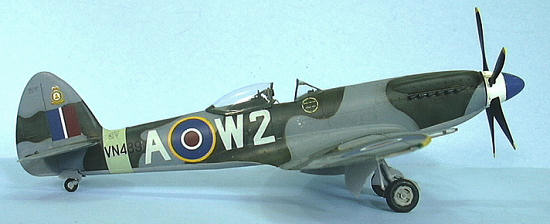 When
this was dry, I gave the model two coats of Xtracrylix Gloss Varnish.
When
this was dry, I gave the model two coats of Xtracrylix Gloss Varnish.
Decals:
I had intended to do the Spitfire
24 of 80 Squadron based in Hong Kong with the black and white ID stripes.
Unfortunately, it turns out that the early-release kits
from Eduard have a decal sheet in which the squadron codes are provided in Dark
Grey, rather than the Light Grey they should be.
(I have been told that this has been fixed in later
kits, but it’s impossible to know without opening the box which sheet you have,
so be warned) Fortunately, down in the lowest catacombs of the Decal Dungeon, I
found an Airfix kit sheet.
I decided that I would do VN489 in the original markings
it carried when first issued to 80 Squadron.
The Airfix Sky fuselage band and serials went down
without a problem under several applications of Solvaset.
The rest of the Eduard kit decals are excellent and went
down without trouble using Micro-Sol.
I used stencils from a Lifelike Decals Spitfire sheet.
| FINAL BITS |
I washed the model and applied two
coats of Xtracrylix Flat Varnish, then attached the canopy in the open position
and attached the wheels.
| CONCLUSIONS |
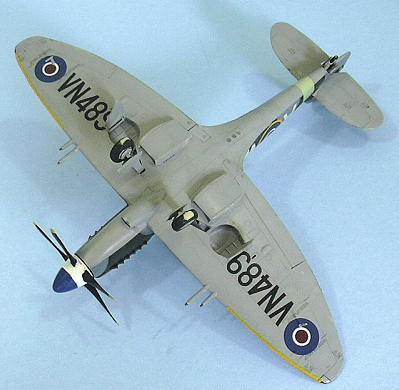 At risk of my fellow Spitfire
purists thinking me not a member of the tribe, I actually like the Griffon
Spitfires the best, because their long noses remind me of Reginald Mitchell’s
racers that were the ancestors of the Spitfire.
The Spitfire 22/24, with that big Spiteful tail and
bubble canopy atop that trim fuselage, look like the ultimate Supermarine
racers.
At risk of my fellow Spitfire
purists thinking me not a member of the tribe, I actually like the Griffon
Spitfires the best, because their long noses remind me of Reginald Mitchell’s
racers that were the ancestors of the Spitfire.
The Spitfire 22/24, with that big Spiteful tail and
bubble canopy atop that trim fuselage, look like the ultimate Supermarine
racers.
March 2009
Copyright ModelingMadness.com
Review kit courtesy of Eduard
If you would like your product reviewed fairly and fairly quickly, please contact the editor or see other details in the Note to Contributors.